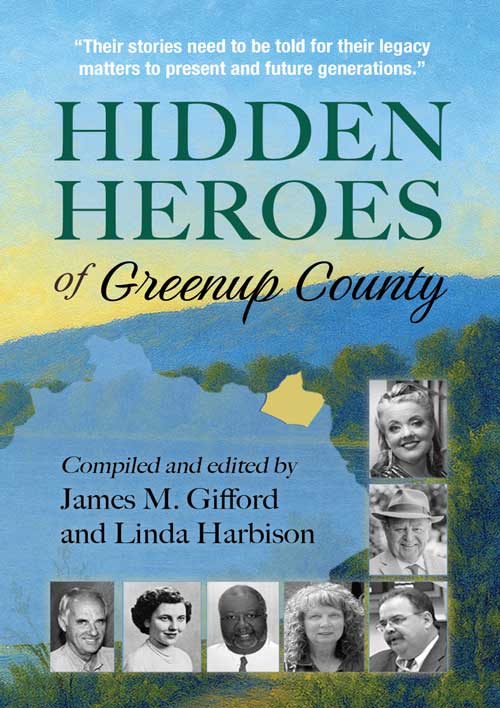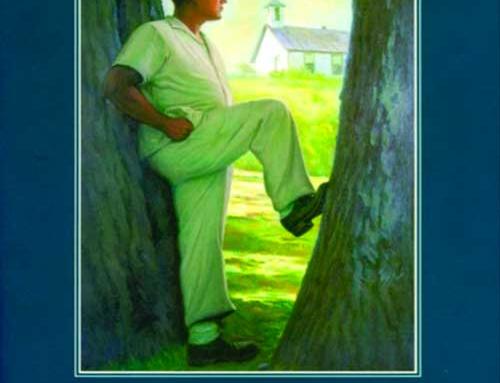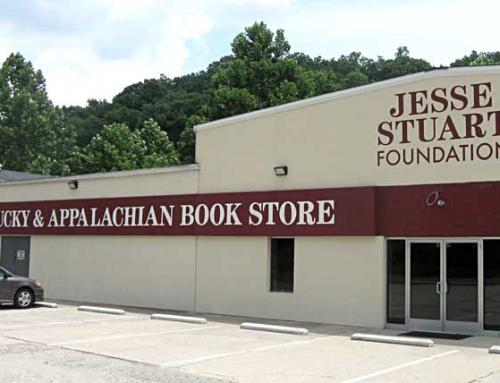When you read this book, you will not find stories about Joe Bates, Terry McBrayer, Billy Ray Cyrus, Jesse Stuart, Don Gullett or dozens of other Greenup Countians who have achieved fame and prominence. The thirty essays in this book are about the county’s hidden heroes, the everyday folks whose hard work and public responsibility have made Greenup County successful. These hidden heroes are representative figures. They represent thousands more whose daily lives improve the quality of life in Greenup County. For the last two decades, Greenup County has suffered several major economic misfortunes. In response to these difficulties, Greenup Countians displayed courage and character, and today the county is not just surviving—it is thriving, and that’s a tribute to the county’s hard-working, caring, responsible people. Their stories need to be told for their legacy matters to present and future generations.
 In 1998, Ashland Oil, which had been headquartered in eastern Kentucky for almost 100 years, announced plans to move its corporate headquarters from Russell to Covington, Kentucky—just south of Cincinnati. The move was complete by early 2020. Hundreds of high-paying jobs were lost, and many employees took early retirement to remain in their eastern Kentucky homes.
In 1998, Ashland Oil, which had been headquartered in eastern Kentucky for almost 100 years, announced plans to move its corporate headquarters from Russell to Covington, Kentucky—just south of Cincinnati. The move was complete by early 2020. Hundreds of high-paying jobs were lost, and many employees took early retirement to remain in their eastern Kentucky homes.
In 2020, residents were devastated to learn that after 67 years in Greenup County, Our Lady of Bellefonte Hospital was closing its doors. Almost 1,000 employees had to find new jobs. Many left Greenup County for positions in other hospitals. That spring the hospital bells rang for the final time and hundreds gathered to share sympathy and concern for a “sad, sad day.”
Another major blow to the county’s economy came in 2019 when AK Steel announced that it would permanently close, eliminating a workforce that had been declining for years. During the mid-twentieth century, Armco, the predecessor of AK Steel, employed more than 5,000 people. In 2021, the Ashland plant was demolished.
After several years of intense economic disappointment, a new aluminum plant projected to be located in northeastern Kentucky promised to revitalize the region’s economy. In 2018 Braidy Industries spent more than one million dollars for land, and a groundbreaking ceremony for an aluminum mill took place in June. CEO Craig Bouchard, supported by a $15 million gift from Kentucky Governor Matt Bevin, promised $65,000-a-year jobs to local residents who graduated from a two-year training program with a B average and a clear drug test.
Two years later, the lack of progress on the underfunded aluminum mill prompted area residents to say, “We’ve been conned!” Braidy Industries had given a false hope to an area struggling to survive the loss of good-paying, blue collar jobs.
Mother Nature made a bad situation even worse with an ice storm that struck the region in mid-February 2021. Many locations saw 0.25″ to 0.50″ of ice from this event which led to difficult and dangerous travel conditions and extended power outages.
In spite of these economic difficulties, Greenup County residents maintained a positive outlook. Cultural tourism aided an ailing economy. Sites visited included the McConnell House, a restored nineteenth-century plantation home; several old iron furnaces; restored covered bridges; markers and monuments devoted to famous citizens, and a beautiful recreational facility at Greenbo Lake State Resort Park. Activities like Old Fashion Days in Greenup and the Jesse Stuart Weekend at the state park attracted local people as well as visitors.
As a county and as a culture, Greenup Countians learned something from the ordeals of the last two decades. They did not surrender to hard times. They simply worked harder.
Today, Americans are suffering economically and emotionally, and the social fabric of our great nation is weakening. Perhaps our nation’s uncertain future makes us more aware of the proud past and insecure present that is the basis for this book. Drawing on the character of their pioneer forbears, Greenup Countians have survived the difficulties of the early twenty-first century because they are a hardy, independent people who work hard and live responsible lives.
The county will survive and prosper because of these hidden heroes. They are people who love their families, homes, state, and nation. They are patriots. They attend church. They support public education. They are quick to help a neighbor or a stranger. The hidden heroes presented in this book represent thousands more just like them. All told, they represent a great county—a county that has refused to surrender to hard times.
I believe that the 30 stories in this book will inform and honor Greenup Countians everywhere, and I hope that this book will inspire continued research and writing about Greenup County and its fascinating residents.
“Hidden Heroes of Greenup County,” a $25, 320-page softback book, is available in the Jesse Stuart Foundation Bookstore, 4440 13th Street in Ashland. The book can be purchased by emailing sales@jsfbooks.com, or by calling 606-326-1667.
By James M. Gifford
JSF CEO & Senior Editor
When you read this book, you will not find stories about Joe Bates, Terry McBrayer, Billy Ray Cyrus, Jesse Stuart, Don Gullett or dozens of other Greenup Countians who have achieved fame and prominence. The thirty essays in this book are about the county’s hidden heroes, the everyday folks whose hard work and public responsibility have made Greenup County successful. These hidden heroes are representative figures. They represent thousands more whose daily lives improve the quality of life in Greenup County. For the last two decades, Greenup County has suffered several major economic misfortunes. In response to these difficulties, Greenup Countians displayed courage and character, and today the county is not just surviving—it is thriving, and that’s a tribute to the county’s hard-working, caring, responsible people. Their stories need to be told for their legacy matters to present and future generations.

In 1998, Ashland Oil, which had been headquartered in eastern Kentucky for almost 100 years, announced plans to move its corporate headquarters from Russell to Covington, Kentucky—just south of Cincinnati. The move was complete by early 2020. Hundreds of high-paying jobs were lost, and many employees took early retirement to remain in their eastern Kentucky homes.
In 2020, residents were devastated to learn that after 67 years in Greenup County, Our Lady of Bellefonte Hospital was closing its doors. Almost 1,000 employees had to find new jobs. Many left Greenup County for positions in other hospitals. That spring the hospital bells rang for the final time and hundreds gathered to share sympathy and concern for a “sad, sad day.”
Another major blow to the county’s economy came in 2019 when AK Steel announced that it would permanently close, eliminating a workforce that had been declining for years. During the mid-twentieth century, Armco, the predecessor of AK Steel, employed more than 5,000 people. In 2021, the Ashland plant was demolished.
After several years of intense economic disappointment, a new aluminum plant projected to be located in northeastern Kentucky promised to revitalize the region’s economy. In 2018 Braidy Industries spent more than one million dollars for land, and a groundbreaking ceremony for an aluminum mill took place in June. CEO Craig Bouchard, supported by a $15 million gift from Kentucky Governor Matt Bevin, promised $65,000-a-year jobs to local residents who graduated from a two-year training program with a B average and a clear drug test.
Two years later, the lack of progress on the underfunded aluminum mill prompted area residents to say, “We’ve been conned!” Braidy Industries had given a false hope to an area struggling to survive the loss of good-paying, blue collar jobs.
Mother Nature made a bad situation even worse with an ice storm that struck the region in mid-February 2021. Many locations saw 0.25″ to 0.50″ of ice from this event which led to difficult and dangerous travel conditions and extended power outages.
In spite of these economic difficulties, Greenup County residents maintained a positive outlook. Cultural tourism aided an ailing economy. Sites visited included the McConnell House, a restored nineteenth-century plantation home; several old iron furnaces; restored covered bridges; markers and monuments devoted to famous citizens, and a beautiful recreational facility at Greenbo Lake State Resort Park. Activities like Old Fashion Days in Greenup and the Jesse Stuart Weekend at the state park attracted local people as well as visitors.
As a county and as a culture, Greenup Countians learned something from the ordeals of the last two decades. They did not surrender to hard times. They simply worked harder.
Today, Americans are suffering economically and emotionally, and the social fabric of our great nation is weakening. Perhaps our nation’s uncertain future makes us more aware of the proud past and insecure present that is the basis for this book. Drawing on the character of their pioneer forbears, Greenup Countians have survived the difficulties of the early twenty-first century because they are a hardy, independent people who work hard and live responsible lives.
The county will survive and prosper because of these hidden heroes. They are people who love their families, homes, state, and nation. They are patriots. They attend church. They support public education. They are quick to help a neighbor or a stranger. The hidden heroes presented in this book represent thousands more just like them. All told, they represent a great county—a county that has refused to surrender to hard times.
I believe that the 30 stories in this book will inform and honor Greenup Countians everywhere, and I hope that this book will inspire continued research and writing about Greenup County and its fascinating residents.
“Hidden Heroes of Greenup County,” a $25, 320-page softback book, is available in the Jesse Stuart Foundation Bookstore, 4440 13th Street in Ashland. The book can be purchased by emailing sales@jsfbooks.com, or by calling 606-326-1667.
By James M. Gifford
JSF CEO & Senior Editor




